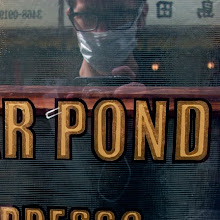There is a wealth of abstraction at this year's VOLTA NY, both in the sense of nonrepresentational art and in the way that the figurative is 'abstracted', and how that presence emerges from the beautiful chaos.
Take a look at the Wohnmaschine booth (D1), out of Berlin, and their American-born video artist Holly Zausner. She took her 2007 film 'Unseen', shot at and around Bode-Museum in Berlin, created like a million screen-grabs of the scenes, then hand-cut and positioned the lot into brilliant mosaics. From a few feet back they resemble anything from shimmering fabric to b&w shadows of tree branches (or a topographical map from way above), depending on the scene. But draw near and the images emerge: the hubbub of the Turkish marketplace in Berlin, smears of color and movement, v. the artist interacting with very live, very dangerous tigers in the sculpture garden of Neue Natioinalgalerie — a mix of full-lengths of Zausner and close-ups of the tiger's face. Up close to her art, we are unable to be just a stoic spectator. We can practically FEEL the hum of the city, the peril of the tigers, the movement of Berlin.
I contrast Zausner w/ Canadian photographer Roberto Pellegrinuzzi, showing in the Montreal-based Pierre-François Ouellette art contemporain (Booth V10). His work show here is carbon ink printed onto layers of mylar and suspended, to great 3D effect. About half the works are composed of rows and rows of postage-stamp-sized cuts of mylar, maquette-style and similar in scale to Zausner's. These up close are total abstraction, blurs of translucent grayish-black ink or enlarged black pixels. But from a distance, the most gorgeous forms emerge, all of them flora-related. Tree branches, fields, an absolutely stunningly massive tree-leaf, captured on several sheets of layered mylar. Here the viewer must adopt an active relation with Pellegrinuzzi's art, as with Zausner, in order to 'feel' the forms in the abstraction.
Jen Liu, based in Brooklyn and showing with her gallery Ceri Hand (Liverpool/Booth F2), is currently fascinating with the stripe. She etches them into her Constructivist-style works, scenes from Tom of Finland and chain-gangs printed on heavy blueprint paper, incising the paper with diagonal slashes or half-concealing the figures with searing pink lines. Think of Rene Magritte's famous late work "The Blank Check" (1965), of a woman on horseback in the woods as, if by illusion, they are partially hidden by the surrounding foliage. That's the effect of Liu's new works, abstracting the scene with stripes but permitting that image to recede and expose itself via the eye's path.
I dug Jered Sprecher's new-wave abstracts at Steven Zevitas Gallery (Booth G1), out of Boston. His basis in screenprinting is evident in these layered geometric works and, after he was awarded the 2009 Guggenheim Fellowship, it seems his canvases have enlarged to outsized proportions. Perhaps it is a dialogue on the Abstract Expressionists of the '60s and their penchant for bigger and bigger canvases. But Sprecher's newer works also immerse you in these deep cascades of translucent colors and fractured shapes. Dannielle Tegeder, showing at W. Chelsea's Priska C. Juschka Fine Art (Booth D9), presents a library-like installation of smaller geometric works on paper, each w/ its own unique frame chosen by the artist. I'm caught in a deep pool of adjectives when surrounded by these jewels, but think of bits of Joan Miró's fascinating forms and Vassily Kandinsky's shapes (plus both artists' vibrant color choices), and the intimate scale of these works reminds me of Tomma Abts' small-scale geometric abstracts — though I find Tegeder's even more readily accessible.
Danny Rolph's (Poppy Sebire Gallery, London, Booth B3) mixed media works on doubled polycarbonate sheets are like symphonic explosions of color, history, pop culture. Think of the singularity, that second before the Big Bang when all the universe's matter was condensed into a single infinitely tiny point. Then picture that w/ '80s references, children's coloring book pages, show ads, and all the colors of the visible spectrum, in all sorts of geometries and textures. That Rolph is able to suspend this vibe in a dual-layered work that embodies tremendous depth is totally wicked, and probably why I cannot pull my eyes from them.
And then we have Rafaël Rozendaal, the young Dutch artist represented by Paris' extra joker/onestar press (Booth A7) (check his totally ace site for reference). Rozendaal's web-based animations and interventions are, on the one hand, impossibly abstract, meaning the source code of these files, lots and lots of dense javascript etc. And yet...the emotional response these unique pieces convey, like the stunning gradient cycle "into time (2010)", where each mouse-click divides the screen into more and more color swatches, is anything but abstract. It is intuitive, spontaneous, authentic emotional reaction. Which, when you think about it, should be the goal of looking at any artwork.
skip to main |
skip to sidebar

